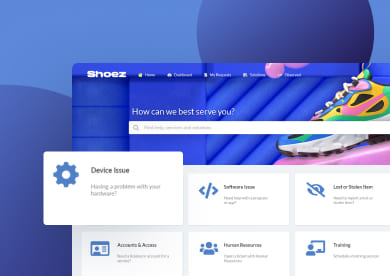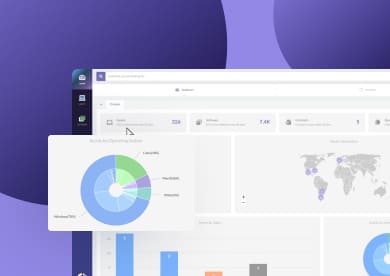AIOps platforms have gained traction because teams are dealing with more alerts, data, and monitoring tools than they can realistically manage. The goal isn’t to replace people, but to reduce the manual work that comes with sorting through alerts, figuring out what’s actually wrong, and figuring out who should respond.
Some tools focus on event correlation. Others lean into automation, anomaly detection, or service-level visibility. In this article, we’ll look at six AIOps solutions, highlight what each one offers, and walk through their strengths, tradeoffs, and pricing models.
You’ll come away with a clearer picture of how they differ – and what to expect if you’re considering any of them. Let’s get started.
What is AIOps software?
AIOps (Artificial Intelligence for IT Operations) software applies machine learning and data analytics to automate and improve IT operations. These platforms ingest data from monitoring, logging, and Service Management tools, then use algorithms to detect patterns, predict incidents, correlate alerts, and support faster resolution.
AIOps is particularly valuable in complex environments where traditional monitoring alone can’t keep up with the volume and variety of operational data.
Here are some key aspects of AIOps:
- Predictive analytics: This is the ability to analyze historical and real-time data to identify patterns and trends and predict potential future incidents or issues before they occur.
- Root cause analysis: AIOps can correlate data from various sources to identify the root cause of incidents more quickly and accurately.
- Automation: AIOps platforms can automate responses to certain types of incidents or anomalies. This includes triggering predefined actions or workflows to address common issues without human intervention.
- Noise reduction: By filtering out irrelevant or redundant alerts, AIOps helps reduce alert fatigue and allows IT teams to focus on the most critical issues.
InvGate for smarter, automated IT management
InvGate brings together Service Management and Asset Management in a single solution that helps IT teams work with more context, act faster, and reduce repetitive issues.
While InvGate is not an AIOps platform, it offers AI-powered features alongside rule-based automation to support smarter operations. This way, it covers several AIOps goals — pattern detection, proactive alerts, faster root cause identification, and fewer recurring incidents — all within a platform designed for everyday IT operations.
InvGate Service Management applies AI to detect recurring problems and flag potentially major incidents. These capabilities help reduce noise and bring structure to incident response and problem analysis.
- Common Problem Detection: Identifies repeated behavior across similar incidents and service requests, surfacing potential problems before they grow into larger disruptions.
- Major Incident Detection: Analyzes severity trends and incident frequency to suggest when an event may qualify as a major incident.
- Predictive Risk and Impact Analysis: Evaluates change requests using past outcomes to suggest potential risk levels and likely impact, helping teams prioritize and plan more effectively.
To complement those features and provide a more complete picture of IT operations, InvGate Asset Management offers rule-based automation and configuration data. Teams gain an additional layer of observability with:
- Asset relationship and dependency mapping: Connects service issues to specific hardware or software, offering more context during triage.
- Health rules for IT assets: Lets teams define thresholds or expected behaviors and receive alerts when conditions deviate.
For organizations focused on practical improvements in Service and Asset Management, it provides intelligent support without the overhead of deploying a dedicated AIOps solution.
Grab a free trial of InvGate and discover our AI Hub!
“A standout feature is the built-in automation of Incident Change Management, which significantly increases productivity by improving the efficiency of repetitive tasks. The reporting and analysis tools are strong and provide valuable insights for decision making and continuous improvement. It provides solid value with comprehensive AI ITSM capabilities.”
User review from Gartner, IT Manager
Top 6 AIOps platforms for 2025
Here’s a closer look at six AIOps tools for automation and real-time analytics.
1. BigPanda
BigPanda focuses on event correlation and operational intelligence. It's designed to reduce alert fatigue by automatically grouping related incidents and identifying probable root causes. Built for large-scale environments, it integrates with a wide range of monitoring and service tools, making it a common choice for enterprise teams handling high volumes of alert data.
BigPanda features
- Noise suppression using machine learning models.
- Root cause analysis based on event correlation.
- Integration with common monitoring and service desk tools.
- Open-box machine learning for transparency and user control.
BigPanda pros and cons
Pros:
- Strong event correlation across large data volumes.
- Open integration model supports diverse environments.
Cons:
- Setup can be time-intensive for complex environments.
- Some users report a learning curve when tuning the correlation logic.
BigPanda pricing details
BigPanda doesn’t publish pricing publicly. It typically offers quote-based pricing, which depends on the volume of events and the number of users or integrations.
BigPanda user reviews and ratings
Users often highlight BigPanda’s ability to cut down alert noise and its ease of integration. Gartner Peer Insights score: 4.3.
“BigPanda has allowed us to ingest and correlate events in the environment from multiple monitoring platforms. This has assisted with identifying the root cause at an accelerated rate.”
User review from Gartner, IT associate
2. Splunk ITSI
Splunk ITSI builds on the core Splunk platform and adds service-aware monitoring with KPIs, anomaly detection, and service impact analysis. It's aimed at organizations that already centralize their log and metrics data in Splunk and want to extend those insights into proactive incident detection and business service visibility.
Splunk features
- Service and entity monitoring with KPIs.
- Glass Tables for customizable dashboards.
- Predictive analytics based on machine learning.
- Episode Review for event grouping and triage.
Splunk pros and cons
Pros:
- Deep customization and flexibility.
- Good for organizations already using Splunk.
Cons:
- High learning curve for new users.
- Licensing and pricing can become complex.
Splunk pricing details
Pricing is usage-based and depends on data ingestion volume. ITSI is an add-on to the core Splunk platform, requiring an additional license.
Splunk ITSI user reviews and ratings
Gartner Peer Insights score: 4.0.
“Product is really good in terms of what it can do, it gives a 360 view of the system and quick to show any issues and points to the correct direction for analysis and resolution.”
User review from Gartner, IT Services
3. PagerDuty
PagerDuty is built for real-time incident response but has expanded into AIOps with features that help reduce noise and automate triage. Its strength lies in orchestrating response workflows across teams and integrating directly with observability tools. It's widely used in DevOps-driven environments where response speed is a priority.
PagerDuty features
- Intelligent alert grouping and suppression.
- Event-driven automation.
- Real-time incident collaboration tools.
- Machine learning-based noise reduction.
PagerDuty pros and cons
Pros:
- Strong focus on real-time response.
- Easy integration with monitoring tools.
Cons:
- Limited in-depth analytics compared to dedicated AIOps platforms.
- Some users report alert fatigue without fine-tuning.
PagerDuty pricing details
Plans start at a team tier with core incident management, while AIOps features are part of higher-tier or custom enterprise plans.
PagerDuty user reviews and ratings
Gartner Peer Insights score: 4.3 G2 score: 4.3. Users appreciate its reliability and ease of use for Incident Management.
“The main goal of alerts is for them to be delivered to the right people through the right channels. This is what Pagerduty does exceptionally well, with easy-to-implement alert forwarding based on the metadata extracted from notifications.”
4. CloudFabrix
CloudFabrix offers a composable AIOps approach with a strong focus on data ingestion and preparation. It supports complex IT environments, including hybrid and multi-cloud setups, and allows teams to build AI-driven workflows through low-code tools. It's often used in scenarios where flexibility and automation at the data layer are key.
CloudFabrix features
- Data ingestion and normalization from various sources.
- AI-based incident prediction and root cause analysis.
- Composable dashboards and workflows.
- Integration with ITSM and monitoring tools.
CloudFabrix pros and cons
Pros:
- Highly customizable with low-code tooling.
- Good for hybrid and complex environments.
Cons:
- Smaller market presence means fewer user resources.
- Interface may feel cluttered for first-time users.
CloudFabrix pricing details
Pricing is not publicly available and typically follows a custom quote model based on features and usage scale.
CloudFabrix user reviews and ratings
It has fewer reviews than mainstream options, but feedback often mentions strong automation and flexibility. Gartner Peer Insights score: 5. G2 score: 4.8.
“The Alert & Event Correlation capabilities are highly effective as the tool reduced almost 70% of the events generated from our observability stack using their built-in AI & ML models.”
User review from G2, COO
5. Dell APEX AIOps Incident Management
Dell APEX AIOps Incident Management (formerly Moogsoft) is one of the early AIOps platforms, built from the ground up for incident correlation and automated root cause analysis. It’s aimed at operations teams that want to cut down on noise and identify issues earlier in the incident lifecycle. Its AI models are tuned for continuous learning from operational data.
Dell AIOps features
- Real-time alert deduplication.
- Root cause detection via AI.
- Workflow automation.
- Integrations with monitoring and collaboration tools.
Dell AIOps pros and cons
Pros:
- Mature platform with proven use cases.
- Effective at reducing alert fatigue.
Cons:
- User interface can feel dated.
- Some users note lag in processing large event volumes.
Dell AIOps pricing details
Dell APEX AIOps Incident Management (formerly Moogsoft) has published its pricing on the AWS Marketplace: $39,286 per year for up to 50,000 events per month.
Dell APEX AIOps Infrastructure Observability (formerly CloudIQ) is included at no additional cost for customers with active Dell ProSupport or higher service contracts for supported infrastructure.
Dell AIOps user reviews and ratings
Dell AIOps isn’t listed in user review platforms. The following reviews are for Moogsoft. Gartner Peer Insights score: 4.5. G2 score: 4.5. Many highlight strong correlation features, though some mention usability gaps.
“The AI ability of the tool to deduplicate the alerts and correlate the events. Its very effective in reducing the noise. I also like its feature of the probable root cause of the issue which helps us immensely in narrowing down to the root cause in a very short time.”
User review from G2, Service Delivery Director
6. LogicMonitor
LogicMonitor is primarily known for infrastructure monitoring, but its AIOps features enhance its core capabilities with anomaly detection and predictive insights. It’s a good fit for teams that want quick setup, a strong out-of-the-box experience, and automated detection of unusual behavior without needing to build custom models.
LogicMonitor features
- Forecasting and anomaly detection.
- Automated topology mapping.
- Event correlation with AI enhancements.
- Dashboards for performance trends.
LogicMonitor pros and cons
Pros:
- Fast to set up with minimal manual configuration.
- Good default dashboards and alerts.
Cons:
- Limited customization for more complex use cases.
- Historical data retention policies can be restrictive.
LogicMonitor pricing details
Pricing varies depending on the number of devices or metrics monitored. AIOps features are bundled into higher-tier plans. The base monitoring service begins at $22 per resource per month and covers essential monitoring for various types of infrastructure, including hybrid environments, cloud services, and more.
To access the AI capabilities, you would need to pay an extra fee starting at $2.50 per GB per month, depending on how long you need to retain your log data.
LogicMonitor user reviews and ratings
Gartner Peer Insights score: 4.4. G2 score: 4.5. Well regarded for its ease of use and speed of deployment. Some feedback suggests room for improvement in advanced analytics.
"Overall experience has been very good with the product and it has definitely helped us troubleshoot and catch issues quicker and make our estate less chance of having an outage. However, it does get let down a little bit from time to time with the support side of things"
User review from Gartner, IT Manager
Conclusion
AIOps platforms are evolving quickly, but they don’t all approach automation or analysis in the same way. Some are tailored for event correlation and incident triage, while others focus more heavily on infrastructure visibility or hybrid monitoring.
The best fit often depends on how much real-time data you have available, how your teams handle service disruptions, and what level of insight you’re looking to add to your existing processes.
Whether you're augmenting ITSM, strengthening observability, or exploring automation at scale, there's a wide range of options that can support different parts of your IT operations.















